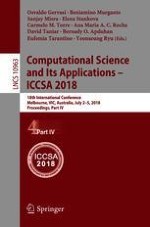2018 | Buch
Computational Science and Its Applications – ICCSA 2018
18th International Conference, Melbourne, VIC, Australia, July 2–5, 2018, Proceedings, Part IV
herausgegeben von: Prof. Dr. Osvaldo Gervasi, Beniamino Murgante, Sanjay Misra, Elena Stankova, Prof. Dr. Carmelo M. Torre, Ana Maria A.C. Rocha, Prof. David Taniar, Bernady O. Apduhan, Prof. Eufemia Tarantino, Prof. Yeonseung Ryu
Verlag: Springer International Publishing
Buchreihe : Lecture Notes in Computer Science
